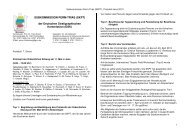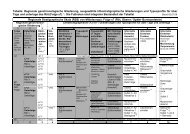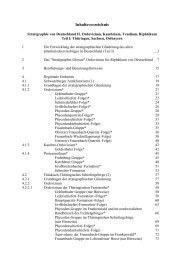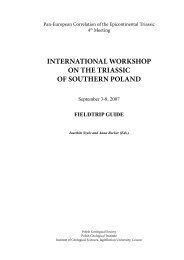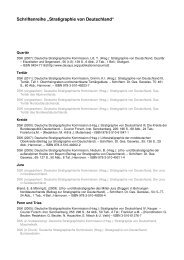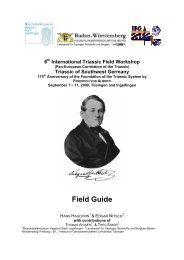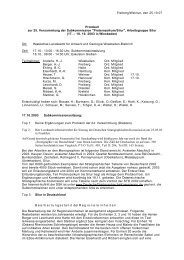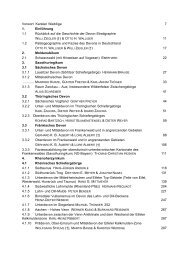International Field Workshop on 'The Triassic of eastern France'
International Field Workshop on 'The Triassic of eastern France'
International Field Workshop on 'The Triassic of eastern France'
You also want an ePaper? Increase the reach of your titles
YUMPU automatically turns print PDFs into web optimized ePapers that Google loves.
layers, with frequent mud-cracks that, laterally, either grade into intraformati<strong>on</strong>al breccias or are totally<br />
eroded by sandst<strong>on</strong>es. They are interpreted as depositi<strong>on</strong> from settling in topographic hollows, located at the<br />
bottomset, after the cessati<strong>on</strong> <strong>of</strong> migrati<strong>on</strong> <strong>of</strong> fluvial barforms, during periods <strong>of</strong> either low water level or<br />
aridity. The floodplain deposits associated with these channel deposits are characterized by laminated<br />
silst<strong>on</strong>es, or fine sandst<strong>on</strong>es, al<strong>on</strong>g with red mudst<strong>on</strong>es. These deposits are thinly layered (a few cm to up to<br />
40 cm in thickness), and very sandy, with some weak bioturbati<strong>on</strong>s in places. They are composed <strong>of</strong><br />
interbedded fluvial overbank, aeolian, and flooded interdune deposits (overbank-interdunes). This facies<br />
associati<strong>on</strong>, characteristic <strong>of</strong> arid envir<strong>on</strong>ments, replaces classic floodplain facies (Langford & Chan, 1989).<br />
The occurrence <strong>of</strong> 3D dunes and barforms, as well as the unimodal paleocurrents and scarcity <strong>of</strong> floodplain<br />
deposits, indicate braided channels. The lack <strong>of</strong> root traces, and the occurrence <strong>of</strong> aeolian deposits associated<br />
within the floodplain provide evidence <strong>of</strong> an arid climate. Moreover, the channels underwent periods <strong>of</strong><br />
cessati<strong>on</strong> in their activity that could indicate the ephemeral character <strong>of</strong> some watercourses. During flood<br />
periods, the formati<strong>on</strong> <strong>of</strong> p<strong>on</strong>ds allowed the ephemeral development <strong>of</strong> subaqueous life (bioturbated facies).<br />
The fluvial c<strong>on</strong>glomerate facies associati<strong>on</strong> <strong>of</strong> the ‘C<strong>on</strong>glomerat principal’ Formati<strong>on</strong> shows vertical<br />
arrangements <strong>of</strong> trough cross-bedded, and rarely planar cross-bedded, gravel to coarse sandst<strong>on</strong>e lenses (dm<br />
to m scale) that does not exceed 3 m in thickness. This facies c<strong>on</strong>tain abundant very rounded gravels,<br />
sometimes <strong>of</strong> dm size, <strong>of</strong> extremely mature (exclusively siliceous) compositi<strong>on</strong>: quartz, quartzite, lydite.<br />
Paleocurrent measurements indicate unimodal directi<strong>on</strong>s, oriented to the NNE, that characterize low<br />
sinuosity channels. These channel deposits seem to be not markedly different from those described below.<br />
However, the lack <strong>of</strong> channel-fill ends (facies Sr), as well as the predominance <strong>of</strong> c<strong>on</strong>glomeratic facies,<br />
suggest a period <strong>of</strong> transit and/or granulometric segregati<strong>on</strong>. At outcrop, this formati<strong>on</strong> has a maximum<br />
thickness <strong>of</strong> 20 m, and shows a great lateral extent towards the <strong>eastern</strong> (Durand, 1974; Bourquin et al.,<br />
2006).<br />
The arid climate prevailing in the sedimentati<strong>on</strong> area is dem<strong>on</strong>strated by the presence <strong>of</strong> many wind-<br />
worn pebbles and cobbles (ventifacts), not <strong>on</strong>ly c<strong>on</strong>centrated in the c<strong>on</strong>glomeratic layers, but also scattered<br />
here and there throughout the ‘Grès vosgiens’ Formati<strong>on</strong>. (Durand et al., 1994).<br />
40



